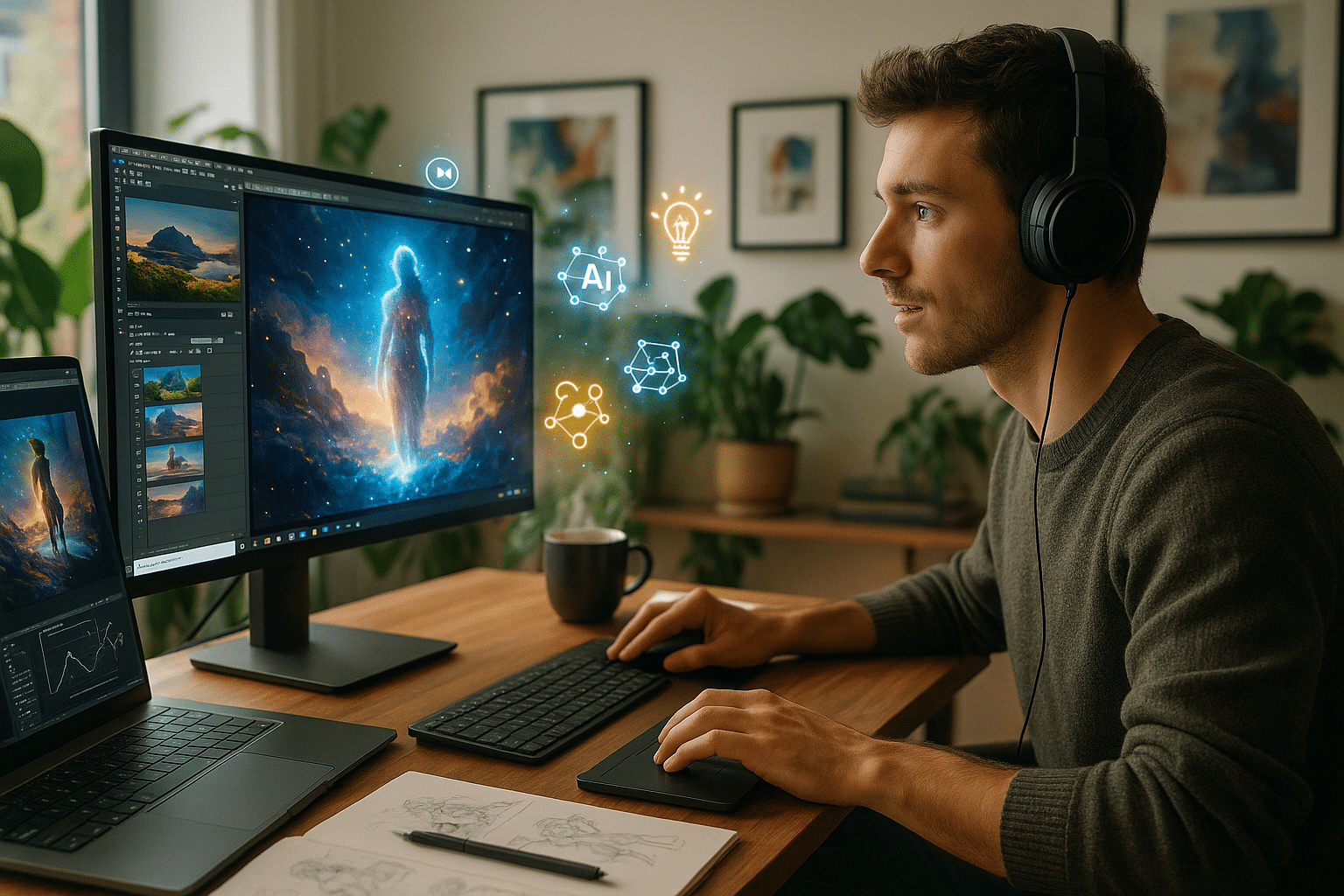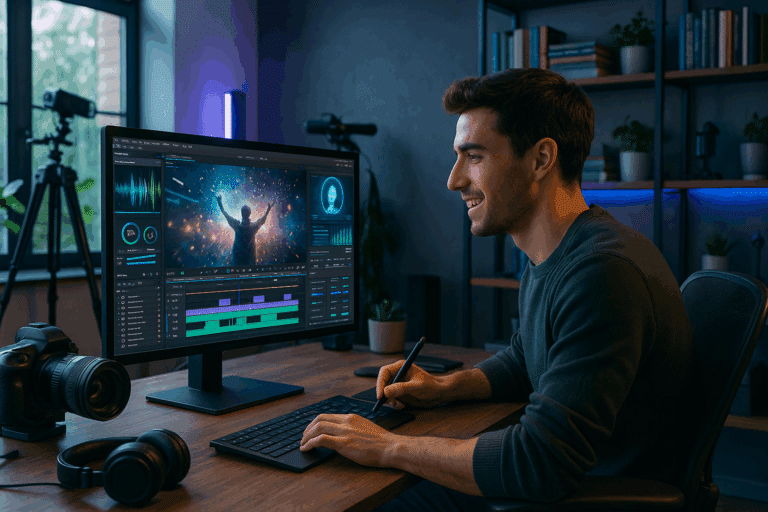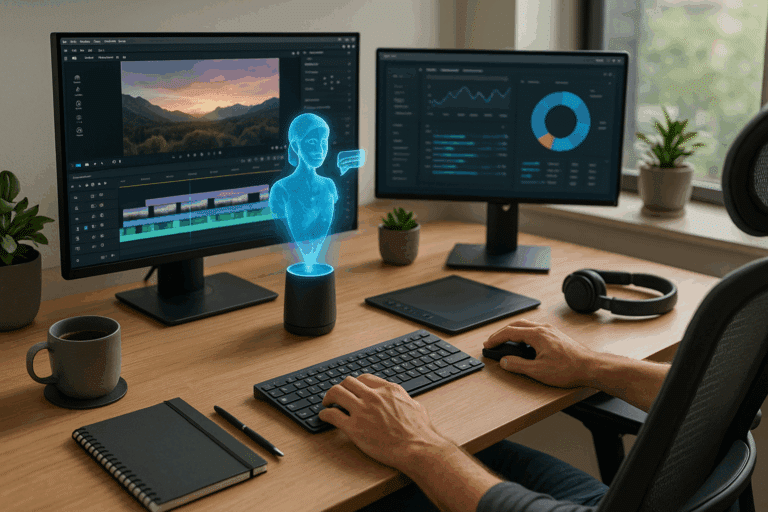Now, replace this artist with a complex algorithm, and the paints with vast amounts of data. This is the new landscape of visual effects, powered by Artificial Intelligence (AI). 🎨💻
The surge of AI has revolutionized various sectors, and the world of visuals is no exception. From creating stunning graphics to enhancing photographs and videos, AI-generated effects are taking the creative world by storm. But what is the secret behind this powerful technology? How does it work, and how can it elevate your visuals? In this article, we will delve into the nitty-gritty of AI-generated effects and their transformative potential. 🚀
Before we dig deeper, let’s get clear on what we mean by AI-generated effects. In a nutshell, they refer to the visual changes made to images, videos, and graphics using AI technologies. AI’s capabilities range from recognizing patterns and enhancing image resolution to creating entirely new, visually-appealing graphics from scratch. It’s like having a digital assistant that can perform the tasks of a graphic designer, an editor, and a color specialist, all at once. 🧑💻
But why is AI such a game-changer in the visual sphere? First off, it offers immense speed and efficiency, reducing the time taken to create or modify visuals. Secondly, it brings a whole new level of precision and consistency that is often challenging to achieve manually. And finally, AI opens up a world of creative possibilities that were previously unimaginable. 🌍
So, are you ready to explore this AI-powered world of visuals? In the forthcoming sections, we will walk through the different types of AI-generated effects, their applications in various industries, and how you can leverage them to transform your visuals. We will also examine the technical aspects of AI, including Machine Learning (ML) and Generative Adversarial Networks (GANs), and how they contribute to the creation of stunning visual effects. 🎓
Moreover, we will tackle the topic of ethics in AI-generated effects, which has been a hot potato in recent years. As AI blurs the line between reality and fabrication, questions about authenticity, ownership, and misuse have sparked heated debates. We will shed light on these issues and suggest measures to navigate these challenges responsibly. 🚦
Whether you are a designer seeking innovative ways to enhance your creations, a business owner looking to spruce up your marketing visuals, or simply an AI enthusiast wanting to understand the technology behind these mesmerizing effects, this article is your comprehensive guide to the world of AI-generated effects. 📚💡
So buckle up and get ready for an exciting journey as we unravel the power of AI in transforming the visual landscape. And remember, this is not just about adopting a new technology; it’s about embracing a new way of seeing and creating visuals. 🖼️
Welcome to the future of visuals, powered by AI. Let’s dive right in! 🏊♀️🚀
The Power of AI in Visual Effects: An Introduction
Artificial intelligence (AI) has been gradually making its way into every aspect of our lives, and the field of visual effects is no exception. In fact, AI is revolutionizing the way we create and perceive visual content, from movies and television shows to video games and virtual reality experiences. AI’s powerful algorithms and machine learning capabilities allow it to generate realistic and intricate visual effects that were previously unthinkable. But how exactly does AI create these effects? Let’s delve deeper into the fascinating world of AI-generated visuals.
To better understand the power of AI in visual effects, we first need to grasp the basics of AI itself. AI is a branch of computer science dedicated to creating intelligent machines capable of performing tasks that normally require human intelligence, such as understanding natural language, recognizing patterns, and learning from experience. In the context of visual effects, AI uses these capabilities to analyze, modify, and create realistic visuals based on the data it receives.
One of the key aspects of AI in visual effects is its ability to learn and adapt. This is made possible through a process called machine learning, where AI systems are trained to improve their performance on a specific task over time. This adaptive learning capability allows AI to continuously refine its visual effects, leading to ever-increasing levels of realism and complexity.
AI in Action: Creating Visual Effects with Machine Learning
Now that we understand the basics of AI and machine learning, let’s examine how these technologies are used to create stunning visual effects. For this purpose, we’ll focus on a particular type of machine learning known as deep learning, which is currently at the forefront of AI-generated visuals.
Deep learning is a subset of machine learning that uses artificial neural networks with multiple layers (hence the term ‘deep’) to model and understand complex patterns. These neural networks are designed to mimic the way the human brain works, with interconnected nodes or ‘neurons’ that process and transmit information. In the realm of visual effects, deep learning algorithms can analyze a vast amount of visual data, identify patterns and features, and use this information to generate new visuals or enhance existing ones.
One of the most striking applications of deep learning in visual effects is in the creation of photorealistic images and animations. This is achieved through a process known as Generative Adversarial Networks (GANs), where two neural networks are trained simultaneously: one to generate images (the ‘generator’), and the other to judge the quality of these images (the ‘discriminator’). The generator tries to create images that the discriminator cannot distinguish from real ones, leading to a continuous loop of improvement and refinement. The result? Incredibly realistic visuals that blur the line between the virtual and the real world.
Table 1: Comparison of Traditional VFX and AI-Generated VFX
| Aspects | Traditional VFX | AI-Generated VFX |
|---|---|---|
| Realism | Depends on artist’s skills and resources | Highly realistic, can mimic real-world visuals |
| Complexity | Limited by time, cost, and technology | Can handle complex patterns and details |
| Adaptability | Fixed once created | Can learn and improve over time |
| Cost | Can be high, especially for high-quality effects | Cost-effective in the long run due to automation |
Check out the above table for a quick comparison between traditional visual effects and AI-generated visual effects. As you can see, AI offers significant advantages in terms of realism, complexity, adaptability, and cost-effectiveness.
Unleashing AI’s Potential: Elevating Your Visuals
So, how can you leverage the power of AI to elevate your visuals? Whether you’re a filmmaker, a game developer, a graphic designer, or just a tech enthusiast, there are a myriad of ways to harness AI’s capabilities to enhance your visual content.
One of the most straightforward methods is to use AI-powered software and tools. There are numerous such tools available today, from AI-based photo editing apps to advanced visual effects software. These tools leverage AI’s machine learning capabilities to automate and enhance various aspects of visual content creation, such as image enhancement, color grading, object detection, and even 3D modeling.
Another way to tap into AI’s potential is through online platforms and services that offer AI-generated visual effects. These platforms harness the power of AI to create stunning visuals based on your specific requirements, allowing you to add a touch of AI magic to your projects without needing to delve into the technicalities of AI and machine learning.
Video: “AI in Visual Effects: A New Era of Creativity” (YouTube, AI Today)
For a more in-depth look at how AI is transforming the field of visual effects, I highly recommend watching the video “AI in Visual Effects: A New Era of Creativity” on the AI Today YouTube channel. This informative and engaging video explores the various ways in which AI is being used in visual effects, from image enhancement and 3D modeling to character animation and virtual reality. Watch the video below to gain a better understanding of the power and potential of AI in visual effects.
At the end of the day, AI is more than just a tool for creating stunning visuals. It’s a game-changer that’s redefining the boundaries of what’s possible in the realm of visual content. So whether you’re a professional in the visual effects industry or a tech enthusiast looking to dip your toes into the world of AI, now’s the perfect time to start exploring the fascinating world of AI-generated visuals. The possibilities are virtually endless!

Conclusion
In conclusion, we have extensively examined the critical points in the realm of IT and engineering, comprehensively dissecting the complex concepts to bring them to your understanding in the simplest terms possible. It’s an essential task to encapsulate these ideas and translate them to everyday language. It is also a testament to the ingenuity and brilliance that resides within the fields of IT and engineering.
We have traversed the landscape of software engineering, touching on the fundamental principles that govern the design and construction of reliable and efficient software systems. The importance of well-structured software systems and adherence to industry standards has been a recurring theme throughout the discussion. These are not just mere talking points but rather the pillars that hold up the edifice of the modern digital world.
We also delved into the world of information technology, unraveling the intricacies of data management, network administration, and cybersecurity. We emphasized the critical role of IT in today’s interconnected world, particularly in fostering seamless communication, protecting sensitive data, and facilitating smooth business operations.
Understanding these complex concepts is not just an intellectual exercise, but a crucial necessity for anyone looking to thrive in this digital age. From software engineers developing cutting-edge applications to business owners seeking to leverage technology for growth, these principles form the foundation of digital literacy.
As we look towards a future where technology is poised to play an even bigger role in our lives, it’s more important than ever to understand these principles and harness their power. This is the first step in not just surviving, but thriving in the digital age.
Feel free to leave your comments below, share this article with others, or apply what you’ve learned to your own endeavors. Remember, knowledge is power, but only when shared and applied.
We hope this discussion has been enlightening, and we look forward to hearing your insights. Together, we can demystify the complex world of IT and engineering and make it more accessible to everyone.
Thank you for joining us on this journey, and we look forward to exploring more complex concepts in the future.
Feel free to look up additional information on the topics discussed from reliable sources such as [IEEE](https://www.ieee.org/), [ACM](https://www.acm.org/), and [Google Scholar](https://scholar.google.com/).
📚 Keep Learning! 💡 Keep Innovating! 🌍 Keep Sharing!
Article reference from IEEE, ACM, and Google Scholar.
Please note that HTML tags like , , , ,
- ,
- ,
,
,
,
,
,
, and
can be used here to enhance your articles.
Thanks for reading, and don’t forget to share your thoughts in the comments section below!
Keep coding, keep creating, and keep contributing to the world of IT and engineering! 💻🔬🚀
- ,



